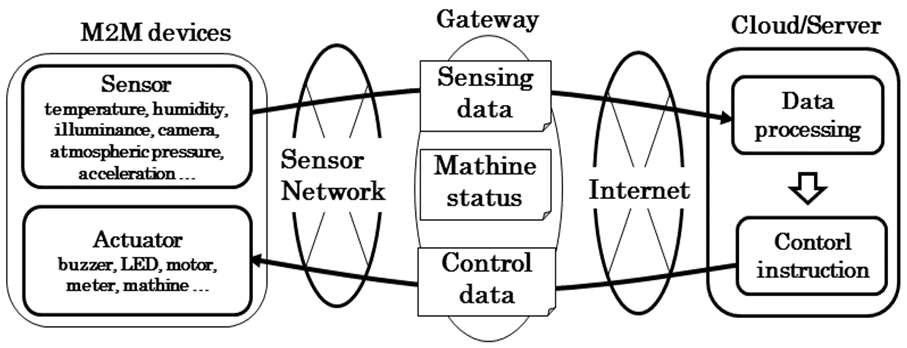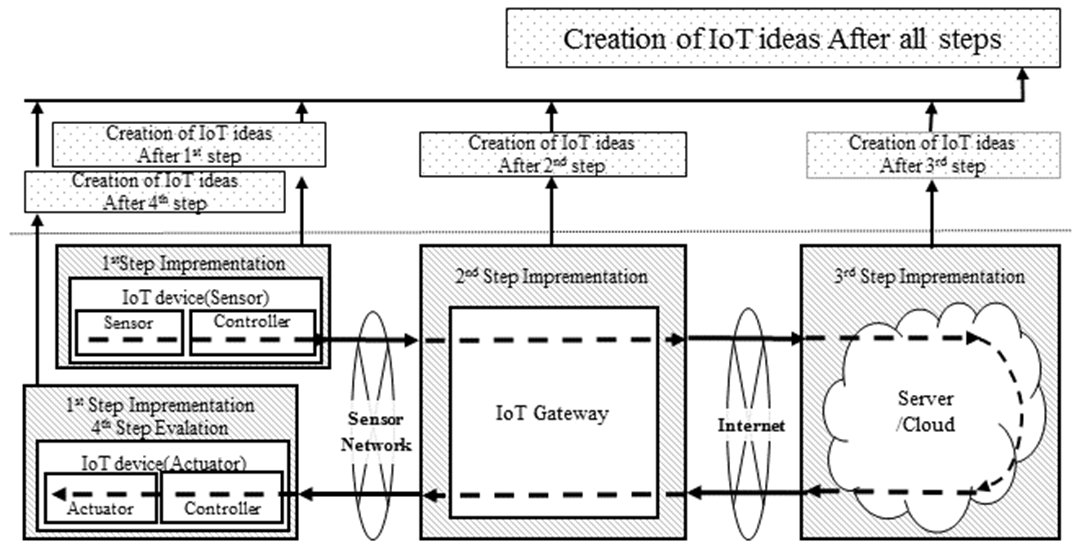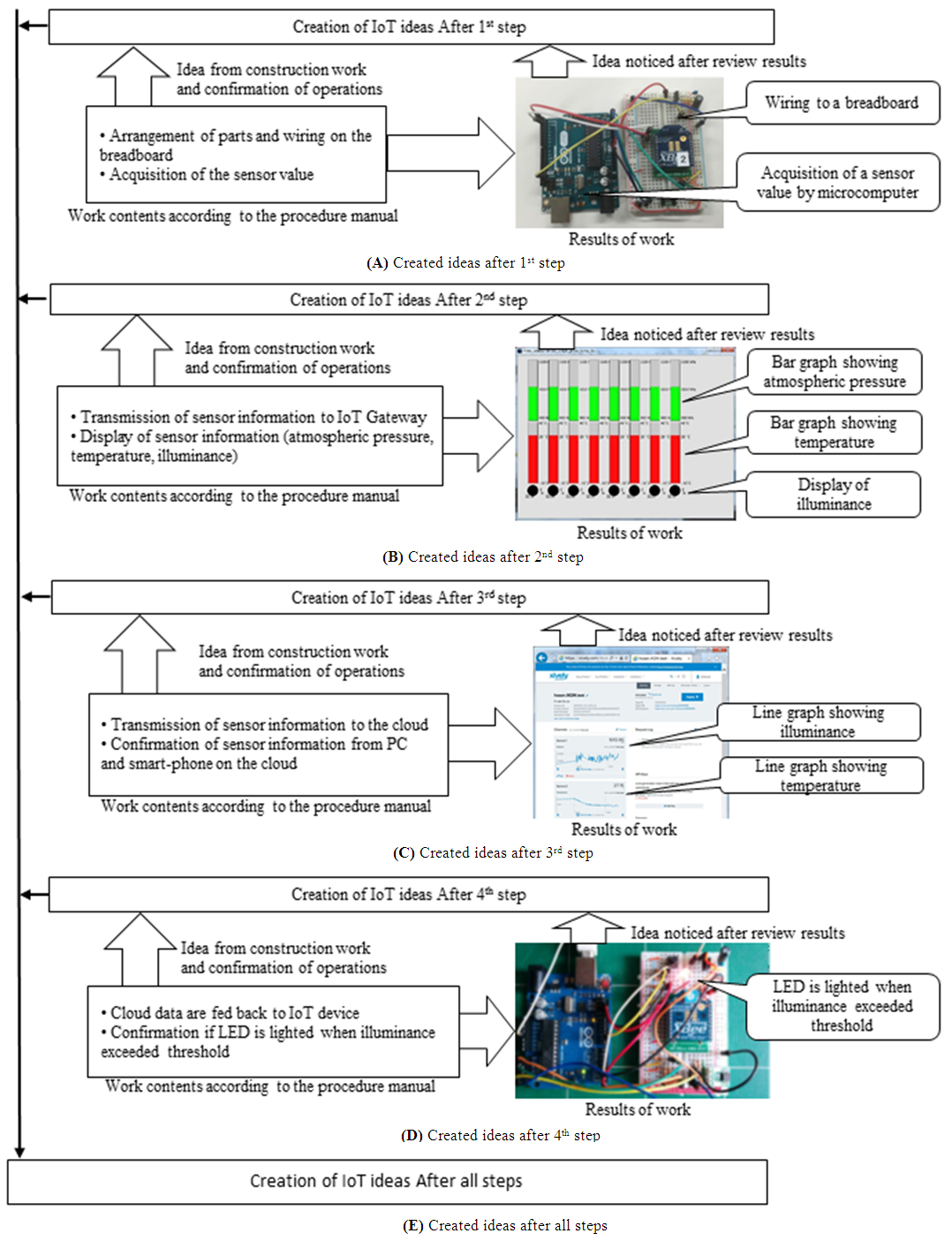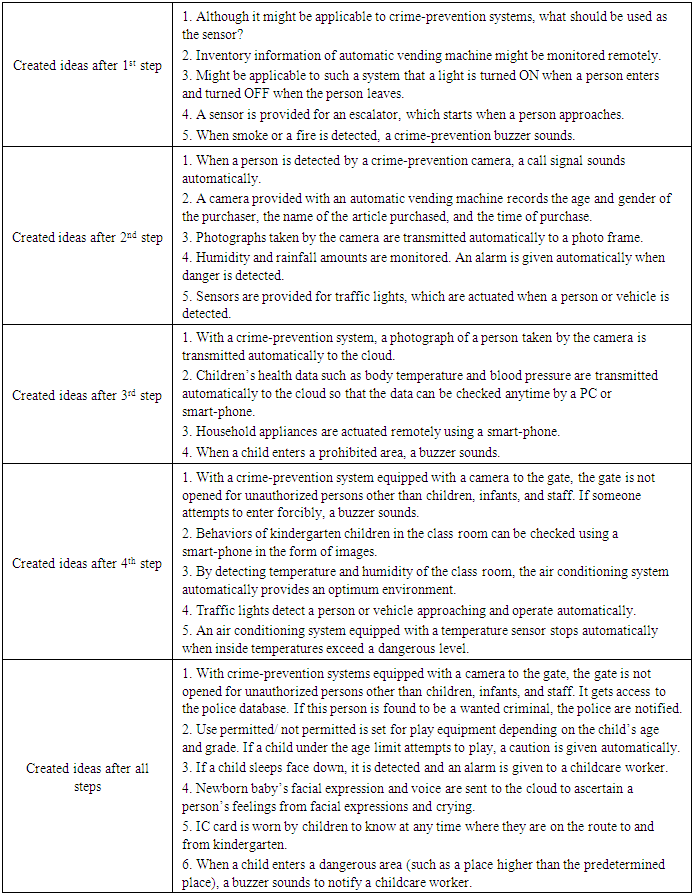-
Paper Information
- Paper Submission
-
Journal Information
- About This Journal
- Editorial Board
- Current Issue
- Archive
- Author Guidelines
- Contact Us
International Journal of Internet of Things
2017; 6(3): 91-97
doi:10.5923/j.ijit.20170603.01

Idea Creation using Stepwise Construction of IoT Prototype System and Its Verification Evaluation
Koji Akiyama1, Masahito Ishihara2, Nobuhiro Ohe3, Masahiro Inoue4, Hidetoshi Kambe5
1Itec Hankyu-hanshin Co. Ltd., Tokyo, Japan
2Hosen College of Childhood Education, Tokyo, Japan
3Melco Techno Yokohama Co. Ltd., Kanagawa, Japan
4Shibaura Institute of Technology, Saitama, Japan
5Tokyo Denki University, Saitama, Japan
Correspondence to: Koji Akiyama, Itec Hankyu-hanshin Co. Ltd., Tokyo, Japan.
| Email: |  |
Copyright © 2017 Scientific & Academic Publishing. All Rights Reserved.
This work is licensed under the Creative Commons Attribution International License (CC BY).
http://creativecommons.org/licenses/by/4.0/

Internet of Things (IoT) systems have been applied increasingly in many areas including industry, agriculture, traffic, welfare, and education. For extension of their fields of application, idea creation associated with characteristic features of respective fields is important. We might surmise that if students, whether humanities courses or science courses, have a chance to receive education of a prototype construction method that allows easy construction of IoT system composition elements, they would construct IoT systems by themselves. We can expect that they can create ideas related to their own areas of expertise using the experience of that construction. Herein, we propose an educational system aimed at idea creation through stepwise construction of an IoT prototype system which students, whether of humanities courses or science courses, can receive willingly. We applied this educational system to lectures for infant education and childcare students and conducted verification evaluation.
Keywords: IoT prototype system, IoT service ideas, Gateway, Cloud, Sensor, Actuator
Cite this paper: Koji Akiyama, Masahito Ishihara, Nobuhiro Ohe, Masahiro Inoue, Hidetoshi Kambe, Idea Creation using Stepwise Construction of IoT Prototype System and Its Verification Evaluation, International Journal of Internet of Things, Vol. 6 No. 3, 2017, pp. 91-97. doi: 10.5923/j.ijit.20170603.01.
Article Outline
1. Introduction
- Internet of Things (IoT) systems incorporate devices that include sensors and perform mutual communication. Typically in such systems, equipment and servers on the cloud are cross-connected via networks, with automatically accumulated data transmitted and received without human intervention to provide various services [1]. In recent years, because of the emergence of falling costs, small sensor devices, and networked equipment, and because of the development of cloud computing, IoT systems have been increasing. The wider and more intensive use of smart-phones and tablet-type devices, which are applicable as IoT devices, has accelerated the spread of IoT systems and their applications.IoT systems have been applied to various applications including industry, agriculture, facilities industries, traffic, distribution, medical care, welfare, and education. For the expansion of fields of application, idea creation associated with characteristic features of each field is important. Furthermore, construction of prototype systems is effective for understanding IoT systems overall. Regarding students, they come to understand IoT system characteristics during construction work, and have the possibility to create ideas of IoT services. Because the created ideas are mostly related to one’s own area of expertise, it is expected that students other than science course students might produce unique ideas.Construction of an IoT system involves plural element technologies. Therefore, the whole system is difficult to understand. However, if an educational method by which construction of the prototype system is possible by either humanities course students or science course students is available, then education of idea creation for IoT system is made available to students other than science course students who are not familiar with the details of element technology of the IoT system. Through education of this sort, students can learn manufacturing and get educational effects for creativity. Conventional researches on IoT system construction have been reported on the architecture of the IoT system and the technologies of its constituent elements, particularly the application of specific fields [2-6]. However, researches on the construction method of the IoT system almost have not been reported. As for the method, only in the software field, efficient development method by the framework is reported [7, 8].We proposed an educational curriculum of IoT prototype system construction for students of the humanities course and practiced it in the class. For construction of a prototype system, composition elements should be combined in a stepwise fashion while one gains information related to actual circumstances [9, 10]. However, in those reports, a method of idea creation using stepwise construction of IoT prototype system is treated as the future task.This paper presents an educational method by stepwise construction of an IoT prototype system aimed at idea creation. Using this method, the IoT system is divided into four composition elements of IoT device, IoT gateway, network, and cloud. Construction of the IoT prototype system is conducted in a stepwise fashion. After practical training in each step, idea creation for services is performed using an IoT system. This system was applied to the class of students of the educational course. Then contents of created ideas were evaluated.
2. IoT Prototype System
- Figure 1 presents a typical basic configuration of an IoT system and data flow. In the figure, the IoT device transmits sensing data acquired by sensors to the IoT gateway via the sensor network. The IoT gateway transmits the sensing data to the cloud via the internet. The sensing data are processed on the cloud, causing IoT device actuators to actuate via the IoT gateway. Consequently, with IoT systems, plural elements work together to establish an effective system.
 | Figure 1. IoT system overview |
3. Proposal of Idea Creation Method in Stepwise Implementation of IoT Prototype
- In this paper, we propose an educational method that students of the humanities course and science course can create ideas using experiences acquired during stepwise construction of the IoT prototype system.
3.1. Composition of IoT Prototype System
- Figure 2 portrays the basic configuration of the IoT prototype. As shown in the lower part of the figure, the IoT prototype system consists of an IoT device, a gateway, and a cloud/server. The IoT device consists of sensors and actuators, and open hardware Arduino [11] and Raspberry Pi [12] are used. Regarding actuators, things of which operations are confirmed easily, such as LEDs, buzzers, and motors are used. Regarding sensors, temperature, humidity, and atmospheric pressure sensors that are easily handled are used. ZigBee [13] is used for the sensor network. Regarding M2M gateway, PC or Raspberry Pi, which can function as the gateway for M2M device side network and cloud network side gateway are used. Xively [14] is used as the cloud service.
 | Figure 2. Basic configuration and stepwise construction of IoT prototype system |
3.2. Stepwise Construction of IoT Prototype System
- [1] 1st stepThe first step covers sensors and actuators on the IoT device. Through this practical training, students will produce a circuit on a substrate using electronic parts such as sensors and actuators and jumper wires, aiming at encouraging students to experience manufacturing. And they produce the IoT device by connecting the circuit and Arduino. Then the program is run and values acquired by the sensors are checked. After practical learning, students are requested to create ideas for services using the IoT system.[2] 2nd stepThe second step covers IoT devices, sensor networks, and IoT gateways. Students implement the IoT gateway on a Windows PC, run the program, and display the data as a graphical representation that is acquired by the sensors and transmitted from the gateway. For mutual communication of the IoT device and gateway, wireless ZigBee is used. After the practical training, students are requested to create ideas for services using the IoT system.[3] 3rd stepThe third step covers the internet and cloud/server in addition to composition of the second step. Students construct a system from the IoT device to the cloud. First, students perform registration of a cloud Xively account. Then they set device settings. The program is run on the gateway. Sensor data are transmitted to the cloud. Data transmitted to the cloud are checked from a browser of a smart-phone or PC. After practical training, students are requested to create ideas for services using an IoT system. Construction of physical equipment composition is completed in the third step.[4] 4th stepIn the fourth step, students construct a system for transmission of the command to the actuator by the data value transmitted to the cloud. Students confirm that the actuator is operated surely when sensor data value on the cloud exceeded the threshold. After practical training, students are requested to create ideas for services using the IoT system.[5] Final stepStudents review ideas created during each step and introduce those being brushed up. Among themselves, they hold discussions to induce newly noticed points.
4. Practice of IoT Prototype Educational Method
4.1. Application of This Method
- We practiced this method with an Infant education class at Hosen college of childhood education [15]. Hosen college has an Infant Education Department and a Childcare Department where kindergarten teachers and children’s nurses are educated and trained. The class curriculum is composed primarily of educational classes such as child psychology and pedagogy. IoT prototype education was implemented 11 times in the information science optional course (Computers in Daily Life), which is held 15 times during the second semester in 2014. In all, 12 students (4 boys and 8 girls; first grade, second grade, fourth grade) took this course. They were divided into three groups. Practical training was performed by groups.The order of practical training shown in the procedure manual to be distributed to the students is designed in such that students can review practical training work by referring to these data after the class. Particularly, for preparation of circuits using a breadboard, what should be wired to which coordinates on the breadboard is presented clearly.
4.2. Practice of This Method
- As shown in Chapter 3, this method consists of stepwise system construction in four steps, idea creation after practical training, and a final step during which ideas created in each step are reviewed and refined.The following description explains the actual status of practical training of this educational method and representative findings by the students. Figure 3 portrays a relation between contents of training execution, results of execution, and idea creation.In the [1st step training] of stepwise system construction training, the target is production of IoT devices and confirmation of operations as depicted in Fig. 3(A). First, sensors and actuators are connected by wiring to form a circuit. Because the wiring positions are designated in detail, almost all students were able to complete the work. At confirmation of operations, students run the program on Arduino and were able to confirm the values acquired by the sensors. Students were interested in an event by which the acquired values change if the illuminance sensor is covered by, for example, a handkerchief.In the [2nd step training], as depicted in Fig. 3(B), students were encouraged to transmit sensor data to the IoT gateway using the Arduino program and to display sensor data received by the Processing program in the form of a graphical representation. Students were impressed to find that results could be confirmed visually. They were also interested in the fact that graphical representation is changed if the environments are darkened by putting a handkerchief over the illuminance sensor.In the [3rd step training], as depicted in Fig. 3(C), students performed transmission of sensor data to the cloud and confirmed it. First, setting of the cloud (Xively) was made. Although they logged in Xively’s homepage and attempted settings, all information was given in English. Therefore, they made little progress. Next, they transmitted sensor data to the cloud and confirmed transmission. Students seemed moved by the fact that data being registered to the cloud could be confirmed on PC or their own smart-phones.In the [4th step training], as depicted in Fig. 3(D), the target is confirmation of feedback of cloud data value to actuator on the IoT device. Particularly, such a program was introduced that when a sensor value exceeded the threshold, a buzzer and LED that act as the actuator are actuated. They were surprised to find that if a cloth put on the illuminance sensor is removed, the LED lit and the buzzer sounded when illuminance exceeded the threshold. They proceeded with practical training.As depicted in Fig. 3(E), students were requested to pick up one idea created up to that point, brush it up using the knowledge acquired from training, and present it for discussion. Almost all students presented questions and opinions actively and enjoyed the discussion. After listening to questions and opinions, many students reflected on the contents they realized and the idea they presented after some discussion.
 | Figure 3. Implementations and created ideas at every step |
5. Evaluation and Discussion
- Evaluations were made mainly for IoT system idea contents created through these trainings.
5.1. Evaluation and Discussion Related to Created idea
- Table 1 presents ideas reported by students at these trainings. If similar ideas are grouped, then a total of 25 items were collected.For ideas created after the 1st step of training, although concrete composition is unknown, many ideas are apparently applicable to crime-prevention, as represented by those of 1. To the question of what sorts of sensors and actuators are necessary for realization of the created idea, fewer than half of the students were able to reply without assistance of the teaching staff. When students consider to IoT systems, they got the impression that they came to realize that sensors and actuators handled during training should be examined.As for ideas reported after the 2nd step of training, many ideas involved sensors and actuators as represented by those of 1: cameras for sensors and buzzers for actuators.Regarding ideas created after the 3rd step of training, an idea in which a sensor is placed in the server which is apparently aware of the cloud, as represented by those of 2, was created for the first time. Regarding the cloud, many students came to understand it for the first time by the third step of training. All students experienced creation of an account in the cloud for the first time.As ideas created after the 4th step of training, ideas recognizing whole IoT systems were created in which, as represented by those of 1, countermeasures were established automatically based on the sensor value and commands are sent to the actuator to cause it to execute the command. Furthermore, many students had concrete views for each composition element of IoT system.Contents of ideas presented after all steps are such that, as represented by those of 1, whole IoT systems are examined, and ideas are added to the public database which are then compared with the input data to determine a control command. Moreover, numerous ideas related to their expertise, infant education, were created.In the first step and second step, no idea was related particularly to infant education, which is their major subject. However, ideas related to kindergarten children and other children appeared in later steps; two out of four in the 3rd step, three out of five in the 4th step, and six out of six after all steps. This is affected by such an event that before idea presentation, they were told that a teaching staff member has an immediate problem and asked if IoT system could resolve this problem. However, for almost all students to select ideas related to own expertise, superficial knowledge of the system is insufficient. They should be acquainted with its contents. It is considered that they gained such understanding from construction of the IoT prototype system.As ideas having higher uniqueness, 3 and 4 given after all steps are particularly noteworthy. Idea 3 is a system by which a child sleeping face down is detected, and an alarm is given to the guardian. Because sudden infant death syndrome (SIDS) occurring with 2–6-month-old infants is frequently associated with sleeping face-down, students were always cautious about this in practical infant training. They intended to apply IoT system to this problem.Idea 4 encompasses such an idea that feelings of newborns, facial expressions, and voice at that time are stored in the cloud, analyzed, and studied to assume their feelings from facial expressions and voice status. This idea is created from such a problem that workers must attend to crying infants during practical training of infants.The ideas described above illustrate the application of IoT systems to cope with immediate problems using IoT devices, network, gateway, and cloud/servers, which are composition elements of IoT systems.Crime-prevention systems shown in each step of 1 in Table 1 were created by a single student. As evident from this table, the level of detail and concreteness of ideas were clarified as the practical training progressed. Coordination between IoT systems devised by students and existing databases such as databases of people wanted by the police are apparent in ideas presented in the final step, which suggests that students can understand the IoT system deeply while experiencing stepwise practical training. They became proficient at investigating composition elements and their functions.
|
5.2. Effects of This Method and Future Task
- In this study, roles of composition elements in the IoT prototype system are explained to students of humanities courses, causing them to practice construction of IoT systems in a stepwise fashion. After obtaining reports of actual feelings related to IoT systems through stepwise construction, students were able to create ideas that were applicable to familiar fields. We realized that after roles of composition elements and coordination between composition elements are learned and understood, and experienced stepwise system composition. Even students other than those of the science course could be educated to a level at which they were able to devise applications of the system through stepwise construction of the system. We consider that students now have a grounding for application of their ideas to immediate problems by changing sensors and actuators of IoT prototype systems provided through this practical training. This knowledge and sophistication are not obtainable by passive learning such as ordinary lectures or learning by videos and books with no accompanying feeling for applications.From the results described above, we consider that education for manufacturing through stepwise construction of IoT prototype system produces a comprehensive learning experience that is independent of the student’s major subject and which contributes to idea creation in each field. This method can be expected to expand to application fields of each area of expertise involving people remotely related to the ICT field.In this study, lectures were held as many as 11 times. When this proposal is applied, the number of class sessions might be limited in many cases. In the future, a method that produces effects through fewer class sessions should be investigated and practiced.
6. Conclusions
- As results of practice, students can construct IoT prototype systems in a stepwise fashion and create ideas that are directly applicable to immediate fields: this method is beneficial to humanities course students. In the future, based on the results obtained here, the authors intend to realize the created ideas in the form of a system. We also intend to modify this method to be applicable to students other than humanities course students, such as those of agricultural courses, information and communication courses, and mechanical courses.
ACKNOWLEDGEMENTS
- This work was supported by JSPS KAKENHI Grant Number 15K00929.
 Abstract
Abstract Reference
Reference Full-Text PDF
Full-Text PDF Full-text HTML
Full-text HTML